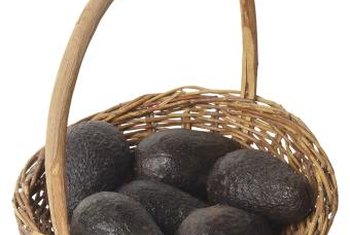
The popularity of avocados reaches back to the Incas, who buried avocado seeds with mummies in 750 B. C. according to the California Avocado Commission. Luckily, there are varieties that grow in climates cooler than those in Mexico.
Avocados are evergreen trees that can reach 30 to 40 feet tall and wide at maturity, although they can be kept smaller with regular pruning. Because avocados need cross-polluntation to produce fruit, horticulturists recommend planting two types of avocados, those with what are called type A and type B flowers. If avocados are common in your area, cross-pollination will occur naturally.
Plant a hardy variety of avocado if you live in a climate with cooler winters. Provide added frost protection by protecting young plants with towels or wrapping the tunk with sponge foam.
Grow the Guatemalan dwarf variety “Holiday,” with type A flowers, if you need to bring your avocado indoors during the winter – it is a good choice for a container plant, but will grow outdoors as well in USDA zones 9b through 10b.
Choose the Mexican variety “Stewart,” with type B flowers, if you need a more compact-sized tree in USDA zones 8b through10b.
Plant your avocado in full sun and give it up to 20 feet to spread its branches. If your yard gets a lot of wind, plant the avocado in a sheltered spot.
Grow avocados in loose, well-draining soil. Add 6 to 12 inches of mulch to retain moisture, but keep the mulch at least 6 inches away from the trunk of the tree to minimize a common root rot called phytophthora.
Water once a week during the growing season using a sprinkler to keep all the soil evenly moistened. To keep from overwatering, water only when the soil on the surface is dry. Give the tree a deep soaking every three to four weeks to wash away natural salts.
Fertilize your tree after the first year with a balanced fertilizer four times a year. For an older tree, apply a high nitrogenous fertilizer in late winter and early summer.
Wrap the trunk of your tree with tin trunk wrapping to protect it from rats and squirrels that eat the fruit.
Inspect the leaves for damage from caterpillars, mites or snails. Handpick them if possible or use a natural pesticide designed for the pest.
Inspect the tree for yellowed or dropping leaves that may indicate root rot and cut back on water if you see damage.